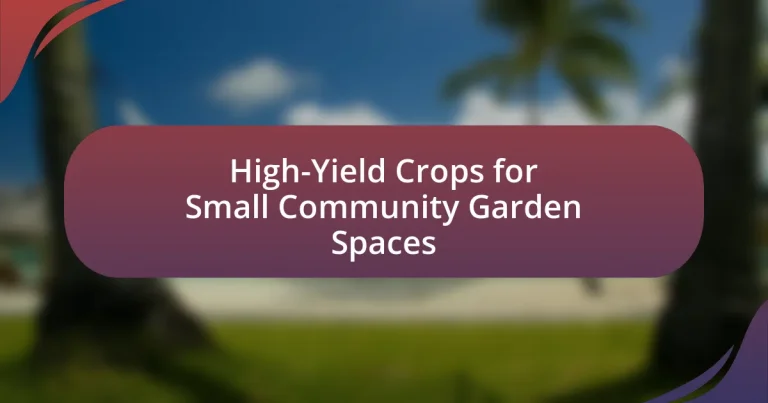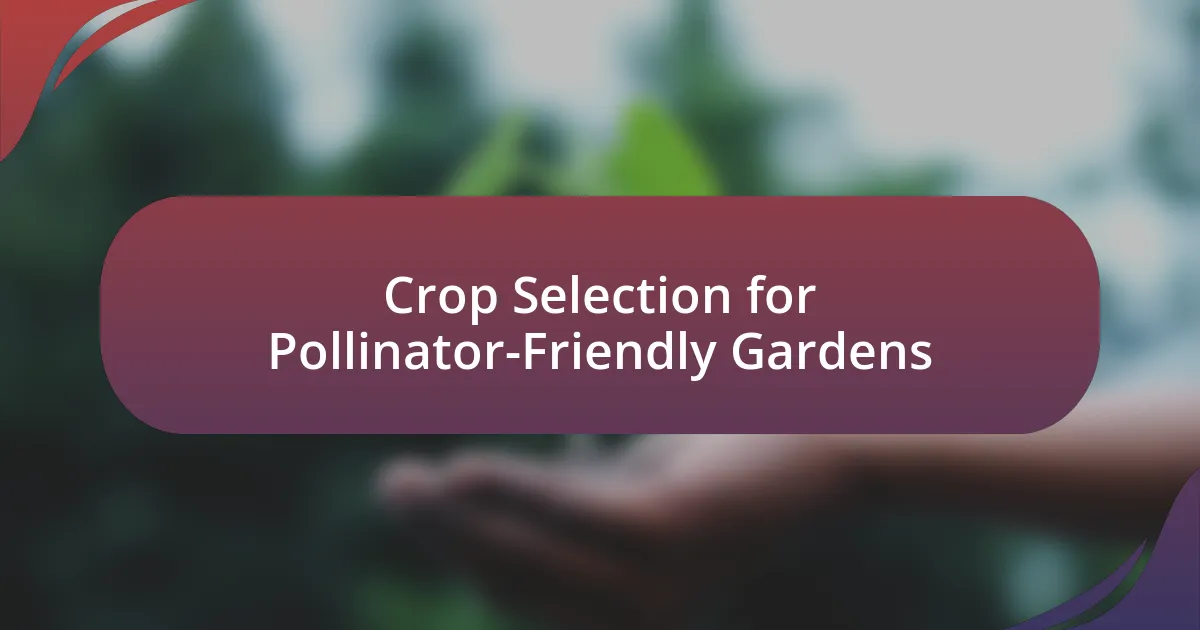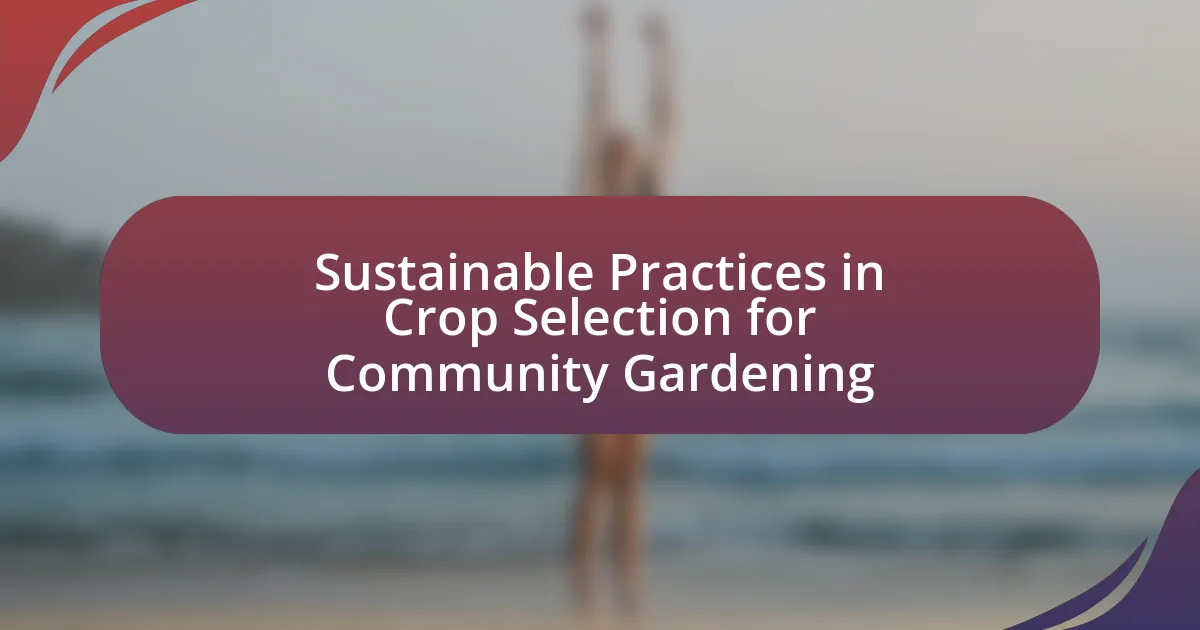High-yield crops are essential for maximizing food production in small community garden spaces. This article outlines various high-yield crops suitable for limited areas, such as tomatoes, peppers, lettuce, and radishes, highlighting their productivity and adaptability. It discusses the differences between high-yield and traditional crops, factors influencing their yields, and best practices for cultivation, including soil health and pest management. Additionally, the article emphasizes the benefits of high-yield crops for community food security and provides practical tips for successful gardening in small spaces.
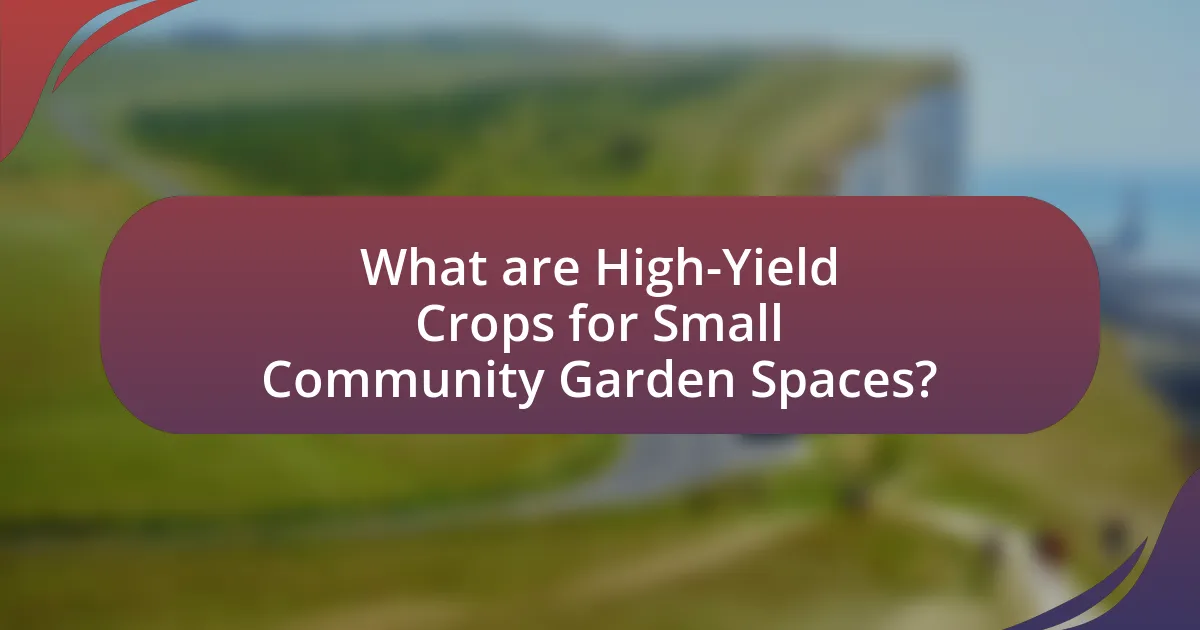
What are High-Yield Crops for Small Community Garden Spaces?
High-yield crops for small community garden spaces include tomatoes, peppers, lettuce, and radishes. These crops are chosen for their ability to produce a significant amount of food in limited space. For instance, tomatoes can yield up to 10 pounds per plant, while peppers can produce around 5 to 10 fruits per plant, depending on the variety. Lettuce grows quickly and can be harvested multiple times, and radishes mature in as little as 30 days, allowing for rapid turnover. These characteristics make them ideal for maximizing productivity in small garden areas.
How do high-yield crops differ from traditional crops?
High-yield crops differ from traditional crops primarily in their ability to produce greater quantities of food per unit area. High-yield varieties are specifically bred or genetically modified to maximize output, often resulting in increased resistance to pests and diseases, improved nutrient use efficiency, and shorter growth cycles. For example, hybrid corn can yield up to 300 bushels per acre, compared to traditional varieties that may yield only 100 bushels per acre. This significant difference in productivity is crucial for addressing food security in limited space, such as small community gardens.
What factors contribute to the yield of high-yield crops?
The yield of high-yield crops is primarily influenced by factors such as soil quality, water availability, climate conditions, and agricultural practices. Soil quality, characterized by nutrient content and pH levels, directly affects plant growth and productivity; for instance, crops grown in nutrient-rich soils can produce significantly higher yields. Water availability is crucial, as crops require adequate irrigation to thrive, especially in arid regions where rainfall is insufficient. Climate conditions, including temperature and sunlight, also play a vital role; optimal growing conditions can enhance photosynthesis and growth rates. Additionally, effective agricultural practices, such as crop rotation, pest management, and the use of high-quality seeds, contribute to maximizing yields. Research indicates that implementing these factors can lead to yield increases of up to 30% in various high-yield crop varieties.
Why are high-yield crops suitable for small spaces?
High-yield crops are suitable for small spaces because they maximize productivity per square foot, allowing gardeners to obtain more food from limited areas. These crops, such as cherry tomatoes and dwarf varieties of vegetables, are bred to produce a significant amount of harvest in compact forms, making them ideal for urban gardening or small community plots. Research indicates that high-yield varieties can produce up to 30% more than traditional crops in the same area, thus optimizing space usage and resource efficiency.
What are the benefits of growing high-yield crops in community gardens?
Growing high-yield crops in community gardens maximizes food production and resource efficiency. High-yield crops, such as tomatoes and peppers, can produce significantly more food per square foot compared to traditional crops, which is crucial in limited space environments. For instance, studies show that high-yield varieties can increase harvests by 20-50%, allowing communities to better meet their nutritional needs. Additionally, these crops often require less water and fertilizer, promoting sustainable gardening practices. This efficiency not only enhances food security but also fosters community engagement and education around sustainable agriculture.
How do high-yield crops maximize space efficiency?
High-yield crops maximize space efficiency by producing a greater quantity of food per unit area compared to traditional crops. These crops are often bred or selected for traits such as compact growth, high productivity, and disease resistance, which allows them to thrive in limited spaces. For instance, varieties like dwarf tomatoes or bush beans require less room while yielding substantial harvests, enabling gardeners to cultivate more food in smaller plots. Research indicates that high-yield varieties can increase productivity by up to 50% in the same area, making them ideal for small community gardens where space is a constraint.
What impact do high-yield crops have on community food security?
High-yield crops significantly enhance community food security by increasing the availability of food resources. These crops produce more food per unit of land compared to traditional varieties, which can lead to a surplus that helps meet local dietary needs. For instance, studies have shown that high-yielding varieties of staple crops like rice and maize can increase yields by 20-50%, thereby providing more food for communities facing hunger. This increased production can reduce reliance on food imports and stabilize local food prices, making food more accessible to vulnerable populations.
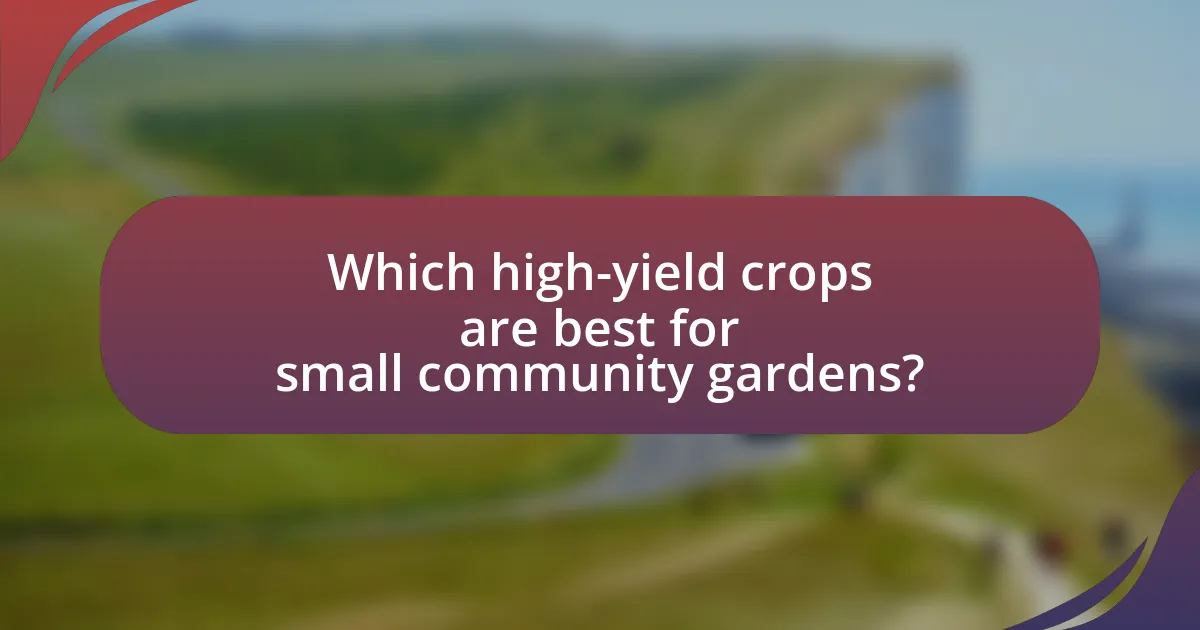
Which high-yield crops are best for small community gardens?
The best high-yield crops for small community gardens include tomatoes, peppers, and lettuce. Tomatoes can produce up to 10-15 pounds per plant in a growing season, making them a highly productive choice. Peppers also yield well, with some varieties producing over 50 fruits per plant. Lettuce grows quickly and can be harvested multiple times in a season, providing continuous yields. These crops are well-suited for limited space and can thrive in various growing conditions, making them ideal for community gardening.
What types of vegetables are considered high-yield crops?
High-yield crops include vegetables such as tomatoes, cucumbers, peppers, and zucchini. These vegetables are known for their ability to produce a significant amount of harvest per square foot, making them ideal for small community garden spaces. For instance, a single tomato plant can yield up to 10-15 pounds of fruit in a growing season, while a cucumber plant can produce 20-30 cucumbers. This high productivity is essential for maximizing space and resources in community gardens.
Which specific varieties of tomatoes are ideal for small gardens?
Determinate tomato varieties are ideal for small gardens due to their compact growth habit and limited height. Varieties such as ‘Patio Princess,’ ‘Tiny Tim,’ and ‘Bush Early Girl’ are specifically bred for container gardening and small spaces, producing fruit in a shorter time frame and requiring less maintenance. These varieties typically grow to about 1-2 feet tall, making them suitable for limited vertical space while still yielding a significant amount of tomatoes.
How do leafy greens contribute to high yields in limited spaces?
Leafy greens contribute to high yields in limited spaces by maximizing vertical growth and minimizing resource requirements. These plants, such as spinach and lettuce, have a fast growth cycle and can be densely planted, allowing for multiple harvests in a single growing season. Research indicates that leafy greens can yield up to 10 times more produce per square foot compared to traditional crops, making them ideal for small community gardens. Their shallow root systems also enable them to thrive in compact areas, utilizing limited soil volume effectively.
What fruits can be grown as high-yield crops in small gardens?
Strawberries, raspberries, and dwarf fruit trees are fruits that can be grown as high-yield crops in small gardens. Strawberries can produce up to 1 pound of fruit per plant in a single growing season, making them highly productive in limited space. Raspberries yield approximately 2 to 5 pounds of fruit per plant, depending on the variety and care. Dwarf fruit trees, such as apple or peach trees, can also be cultivated in small gardens, often yielding 20 to 30 pounds of fruit annually when properly maintained. These fruits are well-suited for small garden spaces due to their compact growth habits and high productivity.
Which berry plants are most productive in small areas?
Raspberries and strawberries are the most productive berry plants for small areas. Raspberries can yield up to 5-10 pounds per plant in a single growing season, while strawberries can produce around 1-2 pounds per plant. Both plants thrive in compact spaces and can be grown vertically, maximizing yield in limited areas. Additionally, their adaptability to container gardening further enhances their productivity in small community garden spaces.
How do dwarf fruit trees fit into small community gardens?
Dwarf fruit trees are ideal for small community gardens as they maximize space while providing high yields. These trees typically grow to a height of 3 to 8 feet, making them suitable for limited areas where traditional fruit trees would be impractical. Their compact size allows for easier maintenance and harvesting, which is beneficial in community settings where multiple gardeners may share responsibilities. Additionally, dwarf fruit trees can produce fruit in as little as 1 to 2 years after planting, significantly enhancing the productivity of small garden spaces. Studies show that incorporating such trees can increase biodiversity and improve soil health, further supporting the sustainability of community gardens.
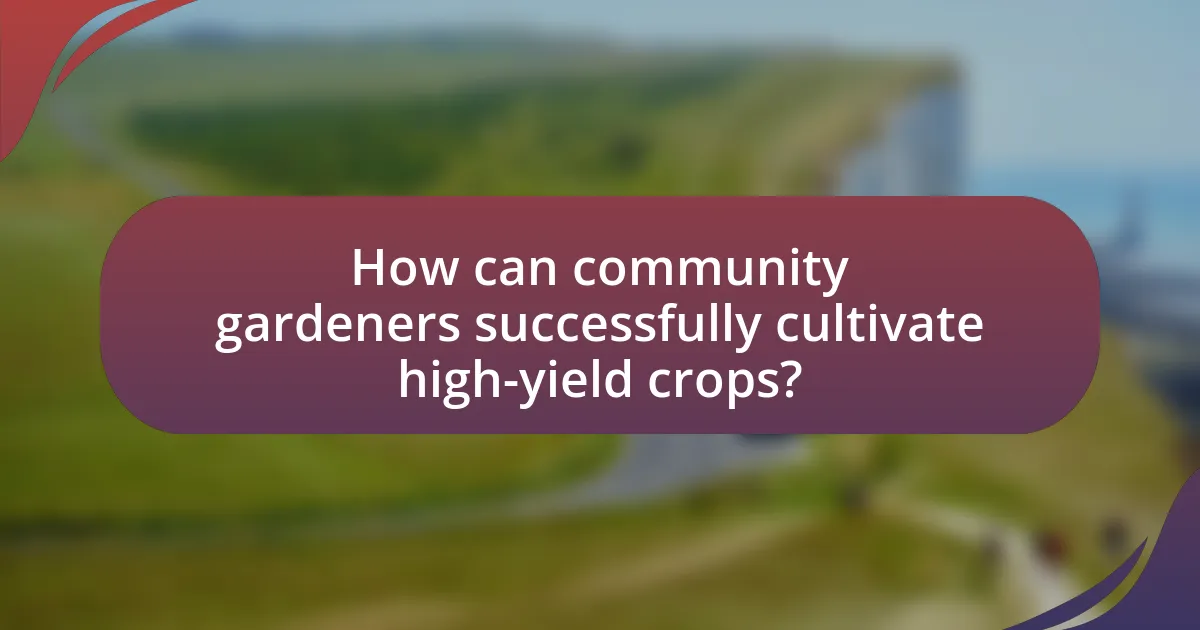
How can community gardeners successfully cultivate high-yield crops?
Community gardeners can successfully cultivate high-yield crops by implementing intensive planting techniques, utilizing companion planting, and optimizing soil health. Intensive planting maximizes space by placing crops closer together, which can increase overall yield per square foot. Companion planting involves growing different crops in proximity for mutual benefits, such as pest control and improved pollination, which can enhance productivity. Additionally, maintaining healthy soil through practices like crop rotation, organic amendments, and proper watering techniques ensures that plants receive the necessary nutrients for optimal growth. Research indicates that these methods can significantly boost crop yields, with studies showing increases of up to 30% in yield when using intensive and companion planting strategies.
What are the best practices for planting high-yield crops?
The best practices for planting high-yield crops include selecting the right crop varieties, optimizing soil health, implementing efficient irrigation techniques, and practicing crop rotation. Choosing high-yield varieties, such as hybrid seeds, can significantly increase productivity; for example, hybrid corn can yield up to 30% more than traditional varieties. Maintaining soil health through organic matter addition and proper pH levels enhances nutrient availability, which is crucial for crop growth. Efficient irrigation methods, such as drip irrigation, conserve water and deliver it directly to the plant roots, improving yield. Lastly, practicing crop rotation prevents soil depletion and reduces pest and disease pressure, leading to better overall yields.
How does soil quality affect the growth of high-yield crops?
Soil quality significantly affects the growth of high-yield crops by influencing nutrient availability, water retention, and microbial activity. High-quality soil, characterized by optimal pH levels, organic matter content, and good structure, provides essential nutrients like nitrogen, phosphorus, and potassium, which are crucial for crop development. Research indicates that crops grown in nutrient-rich soils can yield up to 30% more than those in poor soils, as demonstrated in studies conducted by the Food and Agriculture Organization. Additionally, well-structured soil enhances water infiltration and retention, reducing drought stress and promoting healthier plant growth. Therefore, maintaining high soil quality is vital for maximizing the productivity of high-yield crops in community garden spaces.
What role does crop rotation play in maintaining high yields?
Crop rotation plays a crucial role in maintaining high yields by enhancing soil fertility and reducing pest and disease pressure. By alternating different crops in a specific sequence, soil nutrients are replenished, as different plants have varying nutrient requirements and contributions. For instance, legumes can fix nitrogen in the soil, benefiting subsequent crops. Research indicates that crop rotation can increase yields by 10-25% compared to continuous cropping systems, as it disrupts pest life cycles and minimizes the buildup of pathogens. This practice not only improves soil health but also promotes biodiversity, leading to more resilient agricultural systems.
What common challenges do gardeners face with high-yield crops?
Gardeners face several common challenges with high-yield crops, including pest management, nutrient requirements, and space limitations. High-yield crops often attract pests due to their dense growth, necessitating effective pest control strategies. Additionally, these crops typically require more nutrients than standard varieties, which can lead to soil depletion if not managed properly. Space limitations in small community gardens can also hinder the optimal growth of high-yield crops, as they may need more room for root expansion and sunlight exposure. These challenges are well-documented in agricultural studies, highlighting the need for careful planning and resource management in high-yield gardening.
How can pests and diseases be managed effectively?
Pests and diseases can be managed effectively through integrated pest management (IPM) strategies, which combine biological, cultural, physical, and chemical tools. IPM emphasizes monitoring pest populations and using thresholds to determine when to take action, thereby minimizing pesticide use and promoting sustainable practices. For instance, crop rotation disrupts pest life cycles, while introducing beneficial insects can naturally control pest populations. Research indicates that IPM can reduce pesticide use by 50% while maintaining crop yields, as demonstrated in studies conducted by the University of California Agriculture and Natural Resources.
What strategies can be employed to optimize water usage?
To optimize water usage in small community garden spaces, implementing drip irrigation systems is highly effective. Drip irrigation delivers water directly to the plant roots, minimizing evaporation and runoff, which can lead to water savings of up to 50% compared to traditional watering methods. Additionally, mulching around plants helps retain soil moisture and reduces the need for frequent watering. Research indicates that using drought-resistant plant varieties can further enhance water efficiency, as these plants require less water to thrive. By combining these strategies, community gardens can significantly reduce water consumption while maintaining healthy crop yields.
What tips can enhance the success of high-yield crops in community gardens?
To enhance the success of high-yield crops in community gardens, implement crop rotation, companion planting, and soil health management. Crop rotation prevents soil nutrient depletion and reduces pest buildup, while companion planting can improve yields by utilizing beneficial plant relationships, such as planting tomatoes with basil to enhance growth and flavor. Additionally, maintaining soil health through regular testing, organic amendments, and proper drainage ensures optimal growing conditions, as healthy soil can increase crop productivity by up to 20%.
How can companion planting improve yields and pest control?
Companion planting can improve yields and pest control by enhancing plant growth through beneficial interactions and natural pest deterrence. For instance, certain plants can provide shade, support, or nutrients to their companions, leading to increased productivity. Additionally, some plants release natural compounds that repel pests or attract beneficial insects, reducing the need for chemical pesticides. Research has shown that planting marigolds alongside vegetables can deter nematodes and other pests, while legumes can fix nitrogen in the soil, benefiting neighboring plants. This strategic planting approach not only maximizes space in small community gardens but also promotes a healthier ecosystem.
What resources are available for community gardeners seeking to grow high-yield crops?
Community gardeners seeking to grow high-yield crops can access a variety of resources including local agricultural extension services, online gardening forums, and specialized gardening books. Agricultural extension services provide research-based advice tailored to local conditions, helping gardeners select appropriate high-yield varieties and cultivation techniques. Online forums, such as those on platforms like Reddit or gardening-specific websites, offer community support and shared experiences from other gardeners. Additionally, books like “The Vegetable Gardener’s Bible” by Edward C. Smith provide comprehensive guidance on maximizing crop yields through effective gardening practices. These resources collectively enhance the ability of community gardeners to successfully cultivate high-yield crops.
